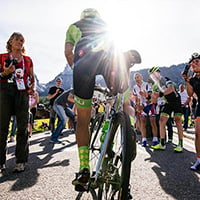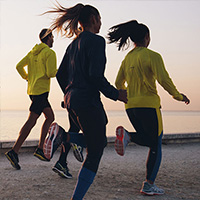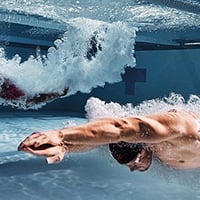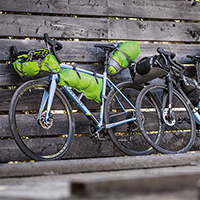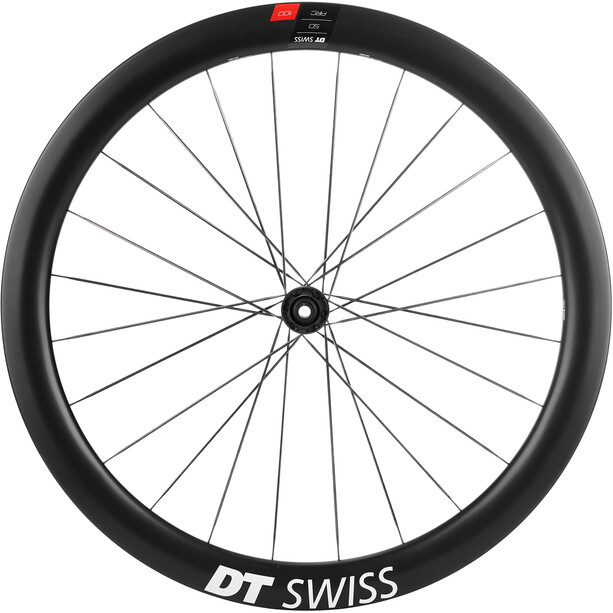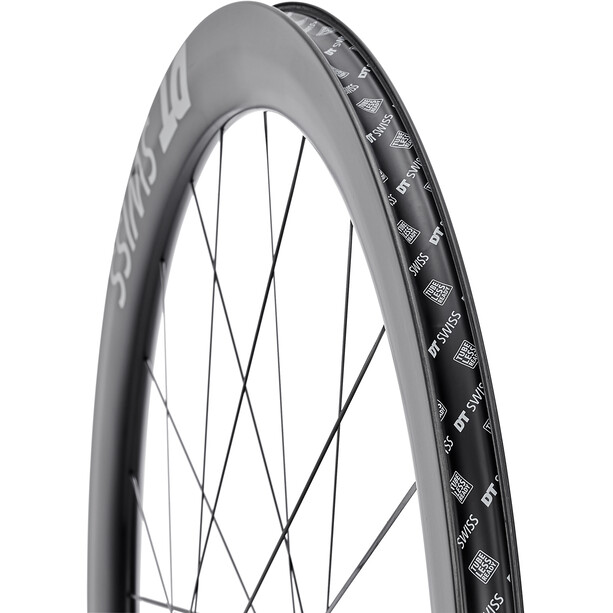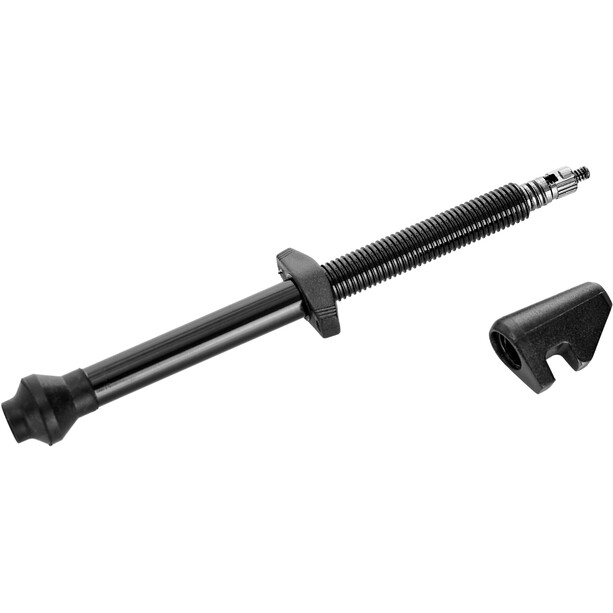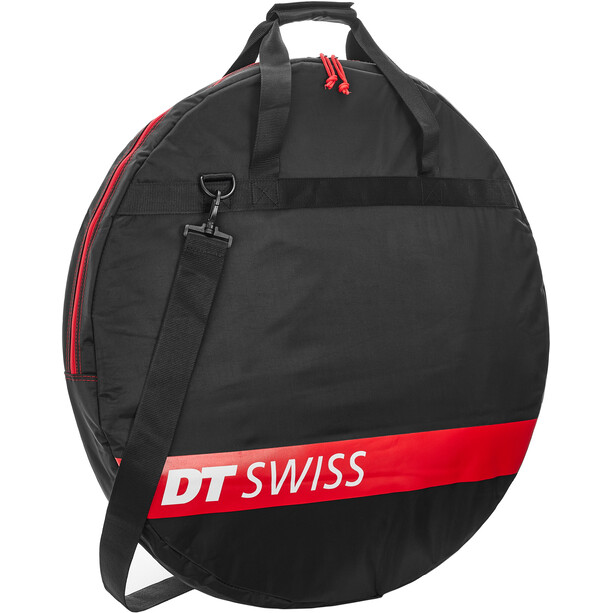Product description
DT Swiss ARC 1100 Dicut Front Wheel 28" Disc CL 12x100mm TA 50mm
ARC 1100 DICUT 50: The most agile and fast accelerating wheelset for hilly or flat courses with sharp turns.
The ARC 1100 DICUT wheels are made to go flat out fast. Available in rim brake version in three different rim heights (80 mm, 62 mm and 48 mm), DT Swisses aero line-up leaves nothing to be desired. Developed in partnership with aerodynamics specialists SWISS SIDE to get up to speed and stay there. Excellent aero-stability and minimal aero drag support the complete system of the rider and his bike. Built up from high quality DT Swiss components and equipped with SINC ceramic bearings the ARC 1100 DICUT wheels give you the reliability you need – no matter if you're fighting against the wind on your time trial bike or trying to escape the bunch on the final meters to the line.
Aero+ - The symbiosis of air resistance, handling and efficiency.
TRANSLATIONAL AERODYNAMIC DRAG
Drag is the aerodynamic force that hits the cyclist in the direction of travel and slows him down. It depends on the speed and the surface of the cyclist's body (75%) and of the racing bike and its components (25%). To minimize this translational air resistance, the contact surface of the entire system must be minimized.
In order to achieve a higher speed, the air resistance of the entire system consisting of rider and road bike must be minimized. This is because air resistance increases exponentially in relation to speed. From 15 km/h onwards, the air resistance is the greatest force that can be overcome. Since the front wheel contributes 8% of the total air resistance, the behaviour of the wheel plays a significant role.
SEGMENT EFFECT
In a cross wind, cyclists and their racing bikes are exposed to lateral forces which influence the riding behaviour. When developing wheels for racing bikes, the aim is to minimize these lateral forces and to provoke a sailing effect - this combined with the best rideability. You can imagine this sailing effect like a sailboat whose sail catches the wind and propels the boat. When cycling, the rim has the same effect and can push the whole system forward. The big advantage in moderate crosswinds with angles of attack between 0° and 20° is that the cyclist is no longer slowed down by the translational drag, but benefits from the reduced drag. Depending on the rim height and its shape, the air resistance can reach negative watt values, which even causes forward propulsion.
Excellent sailing effects in crosswinds occur with increasing angles of attack of up to 18°. In addition, there is a stall, which causes the air resistance to increase again.
ROTATIONAL AIR RESISTANCE
The rotating parts of the bicycle, such as the wheels, not only move forward at a certain speed, but also experience rotational air resistance. The rotational air resistance can be described as the additional friction that occurs when the wheel with the rotating components "cuts through" the air. The rotational drag represents up to 25% of the total drag compared to 75% of the translational drag. Since the spokes are the load-bearing connecting element between rim and hub, they are particularly important in the fight against the wind.
Important to know: The lower the height of the rim, the less the influence of the sailing effect. Longer spokes at low rim heights lead to a higher rotational air resistance.
STEERING TORQUE
Crosswinds generate forces on the wheel and can have an influence on the drivability. Therefore, the ride behaviour must be safe and predictable regardless of external weather conditions such as strong and changing cross and headwinds. To maintain control of the bike at higher speeds, the AERO+ rim should have the lowest possible steering torque.
The racing cyclist therefore benefits from a predictable and therefore controlled steering behaviour, stays longer in the aerodynamically optimal position and reaches higher speeds.
WHY IS STEERING TORQUE SO IMPORTANT?
The racing cyclist feels lateral forces that occur during a bike ride due to crosswinds and passing vehicles (similar to gusts of wind) of different sizes and speeds. They can have a strong influence on the wheel and are sometimes unpredictable and dangerous for the cyclist. The larger the angle of attack (Yaw) and the stronger the wind force, the more the cyclist must constantly adapt to the counterforce required to ride straight ahead in the desired direction.
PHYSICAL EXPLANATION OF THE STEERING TORQUE
An asymmetrical distribution of the force acting on the front wheel in crosswinds generates a steering torque.
WHAT DOES THIS MEAN IN DETAIL?
The lateral force distribution on a wheel rim is asymmetrical in crosswind conditions. This asymmetry generates a moment (steering torque) around the steering axle - i.e. around the axis around which the wheel and fork rotate when steering. One of the development goals of the new AERO+ rim shape was to minimize this asymmetry by distributing lateral forces evenly over the rim in crosswinds. This was achieved by means of CFD (Computational Fluid Dynamics) simulations and confirmed by wind tunnel tests.
ROLLING RESISTANCE
Rolling resistance is about more than just the forces that need to be applied to roll on different surfaces or to overcome obstacles. Wider inner rim dimensions and wider tyres support the driving characteristics such as traction and comfort. Wider tyres tend to have a positive influence on rolling resistance. Due to their larger volume they have a wider contact area and can be driven with less air pressure without the risk of getting a flat tire. While narrow tyres have a longer and narrower contact area, the contact area of wider tyres is "shorter".
As a result, modern tyres roll better due to the easier deformation of the carcass and the contact patch - the rolling resistance decreases.
SINC CERAMIC TECHNOLOGY
At DT Swiss they believe that the difference is in the detail. SINC ceramic ball bearings are precisely based on such details. Thanks to the optimization of these details, a DT Swiss wheel with a SINC upgrade simply means that you will be ahead of the field, your friends or setting new personal bests.
THE HIGHEST QUALITY OF BEARING TECHNOLOGY is installed in all DT Swiss 1100 wheels. The rider benefits from a reduced rolling resistance and an extended durability. SINC ceramic ball bearings have been developed by DT Swiss as a system. They are based on balls made from silicon nitride (Si3N4), an extremely tough and wear- and corrosion-resistant ceramic material. The bearing rings are made from a specially developed steel alloy, which is adapted to the properties of the specific ceramic material used and are precision ground. This combination reduces the rolling resistance to an absolute minimum and guarantees greater durability than conventional ball bearings. But it is not just the bearing itself that is conceived as a system. It's only by using tolerances within a few thousandths of a millimeter and precisely tuning the tolerances of DT Swiss hub bearing seats that SINC ceramic bearings deliver their full potential and offer the decisive advantage over competing products.
ADVANTAGES OF DT SWISS HUBS WITH SINC CERAMIC
Even when installed, the optimum distance between the ceramic balls and the bearing ring (clearance) is ensured. This guarantees minimum rolling resistance and prevents bearing wear. The combination of ceramic bearings and steel bearing rings (hybrid bearings) mean that corrosion between balls and ring is impossible, which significantly improves the lifespan. The bearing ring is also permanently smoothened by the extremely hard balls, which ensures a permanently minimal rolling resistance. The bearing cage, which holds the balls in position, consists of a material ideally suited to the material of the ceramic balls and is specifically developed for each bearing size.
This means that the balls and cage fit together perfectly, which further minimizes friction in the bearing. The high-quality SINC ceramic bearing sealing system guarantees perfect functioning and minimum friction in all conditions. Here is how: A sealing ring is only used on the outside; only a protective ring is used on the inside. The seal seat is precision ground for perfect seal concentricity, which ensures minimum rolling resistance. This technology is unique and is only used for SINC ceramic bearings. Every DT Swiss SINC bearing is individually inspected and tested.
PRO LOCK TECHNOLOGY
Pro Lock is a process where a patented, dual compound, adhesive liquid is injected into the nipple thread, allowing for extremely durable wheel builds. By threading the nipple onto the spoke the adhesive is activated and starts to harden. Retruing the wheel is still possible after the adhesive has hardened completely, with only a minimal decrease of its thread-lock function.
PRO LOCK – FACTS
DT Pro Lock nipples prevent the spoke-nipple connection from loosening.
Wheel durability improves up to 20 times compared to non Pro Lock builds.
Suitable for either hand or machine built wheels. Use of grease or oil not recommended.
All DT Swiss nipples are available with and without DT Pro Lock.
TUBELESS TECHNOLOGY
Tubeless tires offer some decisive advantages over the conventional combination of tire and tube: The tyre can be driven with less pressure without risking "snakebites" and therefore offers more grip. The lower pressure also ensures greater driving comfort. Dispensing with the inner tube means that there is no friction between the tube and the tyre and that therefore the rolling resistance is lower when driving off-road and over obstacles. If tubeless milk is also used, the tyre is also immune to punctures and small cuts. A great advantage for all those who like to ride long distances and away from the nearest bike shop.
The advantages
Tubeless Ready rims from DT Swiss have further advantages over conventional rims. Thanks to the design of their cross-section, the tyre simply pops into place when inflated, so that usually only a normal stand pump is needed. The ingenious tread pattern of DT Swiss rims also ensures that the tyre fits precisely and securely, even under tough driving conditions.
The perfect fit
The profiles of DT Swiss rims are specially designed for tubeless use. They guarantee a perfect fit and make the installation of the tyre as easy as possible. Nevertheless, it is always possible to use a conventional combination of tire and tube.
DT Swiss valve
The use of aluminium saves 40% weight compared to conventional brass valves. The integrated valve tool in the valve cap saves time and effort in finding the right tool for removing the valve insert. The conical valve base ensures a tight fit. The DT Swiss Tubeless valve fits perfectly to DT Swiss rims and ensures a perfect seal for long trouble-free rides.
DT Swiss tubeless band
The DT Swiss Tubeless Ready Tape seals the rim and also functions as rim tape. It is available in different sizes to fit perfectly to the different inner widths of the rims.
The DT Swiss tubeless ready kit
The DT Swiss Tubeless Ready Kit is used to seal the Tubeless Ready rim and thus enables tubeless riding. DT Swiss strongly recommends the use of a high performance tyre sealant even when using tubeless specific tyres. When using Tubeless Ready tyres, the use of the sealant is mandatory (the sealant seals the tyre, which is primarily not airtight). A tubeless structure reaches its full potential only with a sealant! Make sure that the sealant is compatible with the rim, rim tape and tyre. It must not be corrosive or aggressive in any way. If in doubt, contact the sealant manufacturer so that you do not lose your DT Swiss warranty.






























